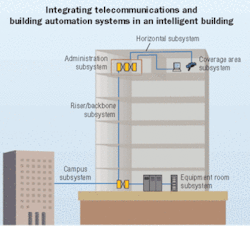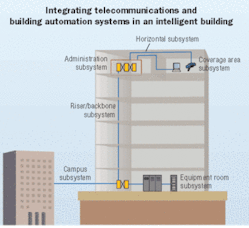Next-gen technologies can link worldwide and building communications in real time, but require a cabling infrastructure to support it.
Technology is on the brink of another leap forward with the advent of collaborative and converged systems. Like PCs and the Internet, these new systems promise to change the fundamental ways in which people and systems cooperate and communicate.
Some of the initial change will be seen in the creation of automated "intelligent" buildings, while additional change may be more spread out. The trigger is the falling price of bandwidth on the LAN and WAN, and will be accelerated further by the "official" arrival of collaborative and converged systems.
Barrier-breaking technology
Collaborative systems integrate and extend PC and Internet technology, breaking down the barriers between the desktop and the Internet. They enable people and computers at different locations, even different countries, to work together productively in real time. Over time, this could reduce the need to concentrate people in central locations, or travel simply for face-to-face meetings.
Communication is a key part of collaboration. Another is a PC desktop software environment that is not only "personal" but also enables colleagues to contribute to a task or project. To make this collaboration fully effective, the software must replicate the real-time interaction of a face-to-face meeting. That means sharing not only data, but also applications, conversations and video images.
The ability to run such real-time communications software requires an infrastructure that will support it. While much of the infrastructure of today's enterprise will not be able to adequately handle the bandwidth requirements or the demands of new building automation technologies and software, infrastructure upgrades promise to solve the problem and prepare the way for the future.
Buildings of the future
As these evolutions and revolutions begin to take place, facilities managers face a host of building services-related issues, including:
- Security, which is a key topic in the face of turbulent times and with the growth in demand for CCTV and access control;
- Fire safety, which is an increasing challenge for high-rise office blocks and large shopping malls, where the ability to locate and contain the fire source and administer access control becomes paramount;
- More efficient and "greener" buildings, which are being called for by health and safety regulations and yet place unforeseen demands on the buildings' ventilation and lighting systems;
- The necessity for a high-performance infrastructure to underpin the ever-spiraling demands placed on the communications network.
To meet these challenges, it is essential to integrate the control of all the building services—advanced security and access control systems, sophisticated fire safety controls, environmental control and monitoring—under one uniform cabling infrastructure. Such an infrastructure will result in an intelligent building.
An intelligent building can be defined by the information and control services that meet the needs of the occupants, the software that controls telecommunications and building automation functions, or by the actual electronic hardware and devices implemented within the structure.
A structured connectivity solution (SCS) is the common ingredient required to integrate the telecommunications (voice, data, video, etc.) and building automation systems (BAS). Other than the SCS, these low-voltage or power-limited services have nothing in common except similar transmission characteristics, such as analog or digital data signals, and the pathways that support and protect the cabling investment (including conduits, cable trays and raceways).
Providing an internationally standardized SCS, and consolidating the horizontal pathways for all the systems that make up the cabling infrastructure of a modern intelligent building can reduce the initial construction costs by 10 to 15%—even up to 30%. The actual level of savings achieved depends on the configuration and geographical pricing for material and labor. An integrated systems approach also enables management to respond quickly and cost effectively to the changing needs of the tenants, which impacts the cost to occupy the space.
In some cases, additional construction expenditures for the SCS or BAS, such as devices to optimize the use of power consumption, may be necessary to reduce operational expenses. Using a total systems integration approach, however, typically can reduce the cabling costs of a new or renovated facility by 25 to 40%.
Typical costs for building operation and alterations over a 40-year lifecycle exceed the initial construction costs. Proper systems integration planning to optimize the construction process can lower these ongoing expenses.
Platform for change
Several cabling issues need to be considered as collaborative and converged systems become more commonplace:
- Video interaction integrated with the standard desktop should cut the cost of remote collaboration dramatically. Its impact on LAN and WAN traffic levels, however, can be equally dramatic. Typically, streaming video coupled with voice needs hundreds of times more bandwidth than text and data files to assure the throughput required; so, a very high bandwidth infrastructure is essential to take advantage of real-time collaboration via the desktop.
Streaming media technology developers have greatly improved the quality/bandwidth trade-off through compression techniques, but they are reaching the limits of what can be achieved. In the WAN, this challenge can be met by leasing more VPN bandwidth. But WAN traffic invariably starts and finishes in the LAN; it is not so quick and simple for businesses to deal with bottlenecks here. Usually, these bottlenecks first occur in the network backbone cabling and switches, where voice and video traffic are aggregated for transmission via the WAN port.
- Quality of service issues also are likely to be most acute in the backbone. Unlike data, voice and video packets cannot be buffered or delayed between transmitter and receiver. Users will be aware of excessive latency in the network instantly, and only a small drop in quality of service will transform videoconferencing from a valuable business tool into a frustrating joke.
- 10-Gigabit Ethernet in the backbone of new network installations is now common, but soon, with hundreds or even thousands of voice- and video-over-IP-equipped desktops sharing a network, even this will not be enough. Multiplying the number of backbone cables and switches is an expensive solution, both in terms of investment and space. Ten Gigabit Ethernet fiber technologies have been developed to meet the challenge in a more economical way, and the 10-Gigabit Ethernet specification has been completed for some time. In fact, even 10-Gbit/sec copper technologies are in early development and expected to become reality in the near term.
Until recently, 10-Gbit/sec optical-fiber solutions were seen as potential options only for expensive singlemode implementations; at these speeds, the business world has entered the realm of laser transmission technology. But transceivers based on vertical cavity surface emitting lasers (VCSELs) now offer the high switching speeds of laser systems at costs closer to those of systems using light-emitting diodes (LEDs).
At the same time, companies have developed multimode fiber that allows VCSEL technology to form part of a complete gigabit LAN solution. This fiber provides all the bandwidth VCSEL electronics need at an affordable price.
Conventional, lower bandwidth 62.5 or 50-µm multimode fibers require complex and expensive transceivers using coarse wave division multiplexing (CWDM) to combine four laser sources at each end to achieve 10-Gbit/sec transmission. But laser-optimized multimode fiber solutions now allow for the use of a simpler and less expensive serial solution that achieves 10-Gbit/sec transmission with the use of a single VCSEL source in the transceiver at each end of the fiber. Consequently, LAN infrastructure costs are forecast to be as much as 35% less than with singlemode or conventional multimode fiber solutions.
Laser-optimized multimode fiber comfortably achieves the 2,000 MHz-km laser bandwidth needed for 10-Gbit/sec serial transmission, and is tested using the Differential Mode Delay (DMD) test method prescribed in the recently ratified international standards. Its precision manufactured 50-µm fiber core is able to sustain this throughput over 300 meters, covering the vast majority of in-building backbone requirements.
This performance level may seem enormous, but with multiple video streams competing for bandwidth, it's also necessary. Clever compression can cut the data rates required, but video of acceptable quality always will have a voracious appetite for bandwidth.
- The "edge" of the LAN lies just beyond the intelligent building—the domain where extended distances come into play. In that realm, enterprises need to plan for the "fat" pipes and wave division multiplexing (WDM) technologies being deployed in the WANs and metro area networks (MANs).
From the edge out (or in) to the end user, for those extended distances, the trend is toward networking with singlemode fiber that has eliminated the hydroxyl peak often associated with optical-fiber cable performance. New singlemode fiber opens up a larger window of wavelengths for use with WDM applications in metro/campus applications.
High performance fiber in the backbone is not the complete solution for reliable, high quality streaming media and building automation systems operating on the LAN. Throughput to the desktop must also be maintained through horizontal runs, patch panels and connectors.
For horizontal runs, companies should seek solutions that provide guaranteed end-to-end throughput far exceeding Category 6 and Category 5e specifications respectively. Similarly, for the backbone, the enterprise would benefit from the use of low-loss LC connectors to ensure that, when coupled with the laser-optimized fiber, end-to-end performance is unrivaled.
Bottleneck busters
By using a combination of these solutions, a business can be sure its horizontal and backbone infrastructure will not be a bottleneck when it introduces real-time collaborative systems. In the near future, fully managed IP services between desktops that are tens, hundreds or thousands of miles apart will become an affordable reality. With guaranteed quality of service and high bandwidth, these systems are destined to bring colleagues together without the frustrations of today's multimedia communications.
So far, the change to decentralized working has been slow, but some technologies, such as Video over IP and the multi-gigabit networks now appearing on the market, point to the probability of an evolutionary leap. When change happens, companies with large reserves of LAN bandwidth will be able to react fast, gaining a decisive advantage over competitors who suddenly realize they need a new cabling infrastructure.
Mike Barnick is senior manager of solutions marketing for SYSTIMAX Solutions (www.systimax.com).

